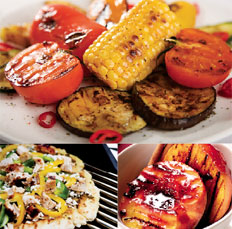It’s certainly true that many foods, when grilled properly, have a flavor that’s unmistakably superior to what you get when you broil, bake, or pan-fry them.
For some consumers, the kiss of pure fire is what makes a steak a steak, for instance. Others can’t imagine eating tuna, swordfish, shrimp, or scallops that haven’t been seared to perfection over an open flame. And some treatments of popular proteins, such as skewers of chicken and lamb, hamburger patties, or bratwurst links, are simply delectable when grilled.
It’s also likely, however, that much of the thrill of grilled food is intimately tied to our taste buds’ striking ability to conjure up images or impressions of past pleasurable experiences in our conscious minds. The taste of grilled meats and vegetables is inextricably associated with summer, barbecues, outdoor gatherings, and life’s simpler pleasures, not to mention our youth.
For some of us, in other words, a bite of a grilled hamburger is like Proust’s madeleine, a tiny fragment of the familiar that summons up a host of impressions, memories, and emotions having little to do with the actual morsel or moment at hand. What’s more, if you buy into the idea of a collective unconscious, then we’re all predisposed to love grilled food because our distant forbearers knew no other type of cooking.
Now, if your quick-serve kitchen operation happens to comprise a grill, cashing in on our deep-rooted and abiding love of flame-cooked food is easy. But what about those establishments that happen to work with clamshells, flat tops, or other, more traditional, fast food hardware? What can they do to seize on humankind’s hankering for grilled fare?
Avoid tearing up the kitchen, kicking the clamshell to the curb, or rewriting the operation’s manual from front to back. It is possible to offer guests a fine simulation of the outdoor barbecue experience simply by working with your suppliers to source grilled accompaniments, condiments, or add-ons that deliver the taste, texture, and look of foods that have been charred just the way we love them.
Here’s an example of what I mean. About 12 or 13 years ago, we at the Center for Culinary Development worked with a major packaged foods manufacturer to develop a line of frozen entrées containing fire-roasted vegetables. Those veggies had been grilled and promptly frozen, so the taste of the open flame remained part of the flavor profile when the meals were heated at home.
Today, this seems like a no-brainer: Frozen, fire-roasted vegetables are everywhere. But at the time, providing them with a serving of a standard (read: ungrilled) protein was somewhat revolutionary in the frozen-foods world. What we effectively did was telegraph the look and feel of a freshly prepared grilled meal through the addition of one grilled component.
Building on that concept, I know today’s quick serves can do something similar.
- Just as many Mexican concepts make smoky salsas and sauces available to provide a little authentic outdoor flavor, some chains might consider offering grilled lettuce to their tacos, tamales, or salads or pesto-grilled corn-on-the-cob as a side. Most chains haven’t yet tapped into the satisfying taste and texture that grilled lettuce adds to almost any dish, but the searing process brings about a much more intense flavor that many diners find addictive. If grilled vegetables aren’t an option, then by all means, continue to explore ways to deliver that smoked or charred taste via condiments and sauces. Fire-roasted red pepper remoulades can add a little heat and sweetness to a variety of different menu items, as can chipotle-mayo spreads and smoked crema sauces.
- A grilled pizza, for some diners, is the ultimate prize pie. But by sourcing any combination of grilled dough, sauce made from grilled tomatoes, and grilled eggplant, zucchini, asparagus, or summer squash, a clever chain might come close to the taste of a grilled pizza without actually having an open flame anywhere in the restaurant. Again, it’s all about having one or more elements that bring the sensation of grilling to the guest’s palate.
- Popular sandwich chains, meanwhile, have already discovered the magical allure of the toasted sub. Just imagine how much more appealing a toasted sub could be with additions such as grilled cheeses or grilled tomatoes, lettuce, onions, and corn.
- Then there are desserts. Ever tried grilled-peach cobbler or a grilled-apple tart? Maybe even a grilled-pineapple upside-down cake? Suffice it to say, grilling fruit caramelizes the sugars in ways that turn the original treat into something much more distinctive and memorable. While your suppliers may not be overwhelmed with requests for frozen, fire-roasted fruit today, striking the right arrangement could make for unusual, yet tempting, dessert options.
It’s worth remembering that grilling—far from being a static pastime—is constantly evolving to incorporate new trends and exotic influences. If grilling lettuce or peaches seems foreign, consider the widening range of international flavors now beginning to inform grilling habits here in the U.S.
As barbecue guru and CCD Chefs’ Council member Steven Raichlen, author of numerous books on grilling including the upcoming Planet Grilling, recently noted: “I think you’re going to see a lot of global influences in grilling in the next few years: Indian naan, South American barbecue—note the proliferation of Brazilian steak houses and Argentinean chimichurri—Southeast Asian satay, and so on.”
Whether or not each one of these trends catches fire in coming years, the point is that our culinary culture never tires of fire. And that makes it worthwhile for quick serves to consider new ways to get a little more smoke on the menu.











